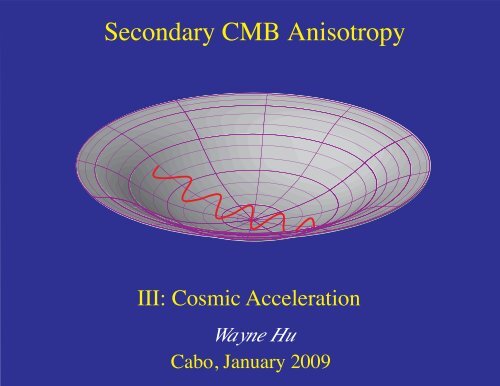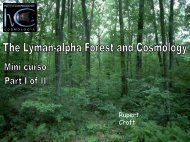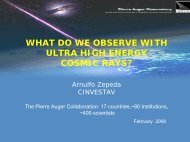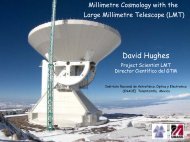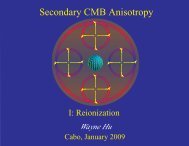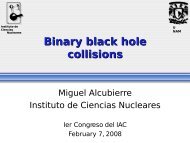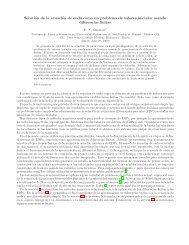Secondary CMB Anisotropy
Secondary CMB Anisotropy III - BCCP â Berkeley Center for ...
Secondary CMB Anisotropy III - BCCP â Berkeley Center for ...
- No tags were found...
Create successful ePaper yourself
Turn your PDF publications into a flip-book with our unique Google optimized e-Paper software.
<strong>Secondary</strong> <strong>CMB</strong> <strong>Anisotropy</strong><br />
III: Cosmic Acceleration<br />
Wayne Hu<br />
Cabo, January 2009
<strong>Secondary</strong> <strong>CMB</strong> <strong>Anisotropy</strong><br />
III: Cosmic Acceleration<br />
Wayne Hu<br />
Cabo, January 2009
Physics of <strong>Secondary</strong> Anisotropies<br />
Primary Anisotropies<br />
recombination<br />
z~1000<br />
Doppler<br />
Vishniac<br />
Lensing<br />
Patchy rei.<br />
reionization<br />
z~10<br />
SZ<br />
ISW<br />
acceleration<br />
z~1
Scattering Secondaries<br />
100<br />
∆T (µK)<br />
10<br />
1<br />
Doppler<br />
suppression<br />
density–mod<br />
linear<br />
ion-mod<br />
SZ<br />
0.1<br />
10 100 1000<br />
l
Gravitational Secondaries<br />
100<br />
∆T (µK)<br />
10<br />
1<br />
0.1<br />
ISW<br />
lensing<br />
Moving Halo<br />
10 100 1000<br />
l<br />
un–<br />
lensed
Integrated Sachs-Wolfe<br />
Effect
ISW Effect<br />
• Gravitational blueshift on infall does not cancel redshift<br />
on climbing out<br />
• Contraction of spatial metric doubles the effect: ∆T/T=2∆Φ<br />
• Effect from potential hills and wells cancel on small scales
ISW Effect<br />
• Gravitational blueshift on infall does not cancel redshift<br />
on climbing out<br />
• Contraction of spatial metric doubles the effect: ∆T/T=2∆Φ<br />
• Effect from potential hills and wells cancel on small scales
Smooth Energy Density & Potential Decay<br />
• Regardless of the equation of state an energy component<br />
that clusters preserves an approximately constant<br />
gravitational potential (formally Bardeen curvature ζ)
Smooth Energy Density & Potential Decay<br />
• Regardless of the equation of state an energy component<br />
that clusters preserves an approximately constant<br />
gravitational potential (formally Bardeen curvature ζ)<br />
• A smooth component contributes<br />
density ρ to the expansion<br />
but not<br />
density fluctuation δρ to the Poisson equation<br />
• Imbalance causes potential to decay once smooth<br />
component dominates the expansion
ISW Spatial Modes<br />
• ISW effect comes from nearby acceleration regime<br />
• Shorter wavelengths project onto same angle<br />
• Broad source kernel: Limber cancellation out to quadrupole
Quadrupole Origins<br />
• Transfer function for the quadrupole<br />
0.2<br />
total<br />
T E 2<br />
T Θ 2<br />
0<br />
-0.2<br />
0.002<br />
0<br />
ISW<br />
SW<br />
total<br />
10<br />
3<br />
z
Smooth Energy Density & Potential Decay<br />
• Regardless of the equation of state an energy component<br />
that clusters preserves an approximately constant<br />
gravitational potential (formally Bardeen curvature ζ)<br />
• A smooth component contributes<br />
density ρ to the expansion<br />
but not<br />
density fluctuation δρ to the Poisson equation<br />
• Imbalance causes potential to decay once smooth<br />
component dominates the expansion<br />
• Scalar field dark energy (quintessence) is smooth out to<br />
the horizon scale (sound speed c s =1)<br />
• Potential decay measures the clustering properties and<br />
hence the particle properties of the dark energy
ISW & Dark Energy
Dark Energy<br />
• Peaks measure distance to recombination<br />
• ISW effect constrains dynamics of acceleration<br />
[ l(l+1)C l /2π ] 1/2 (µK)<br />
100<br />
80<br />
60<br />
40<br />
Dark Energy Density<br />
Equation of<br />
State<br />
20<br />
Ω DE<br />
0.2 0.4 0.6 0.8<br />
10 100 1000<br />
l<br />
w DE<br />
-0.8 -0.6 -0.4 -0.2 0<br />
10 100 1000<br />
l
Dark Energy Sound Speed<br />
• Smooth and clustered regimes separated by sound horizon<br />
• Covariant definition: c e 2 =δp/δρ where momentum flux vanishes<br />
• For scalar field dark energy uniquely defined by kinetic term<br />
0.10<br />
c e =10 1<br />
(Φ−Φ s )/Φ s<br />
0.05<br />
10 0.5<br />
1<br />
10 -0.5 10 -1 10 -1.5<br />
0<br />
w DE =-0.8<br />
Hu (1998)<br />
10 -4 10 -3 10 -2<br />
Garriga & Mukhanov (1999) k (Mpc -1 )<br />
[plot: Hu & Scranton (2004)]
Dark Energy Clustering<br />
• ISW effect intrinsically sensitive to dark energy smoothness<br />
• Large angle contributions reduced if clustered<br />
10 -9<br />
ΘΘ<br />
l(l+1)C l /2π<br />
10 -10<br />
10 -11<br />
ISW<br />
total<br />
c e =1<br />
c e =0.1<br />
10 -12<br />
w=-0.8<br />
Hu (1998); [plot: Hu & Scranton (2004)]<br />
10 100<br />
l
ISW-Galaxy Correlation<br />
• Decaying potential: galaxy positions correlated with <strong>CMB</strong><br />
• Growing potential: galaxy positions anticorrelated with <strong>CMB</strong><br />
• Observations indicate correlation
ISW-Galaxy Correlation<br />
• ~4σ joint detection of ISW correlation with large scale structure<br />
(galaxies)<br />
• ~2σ high compared with ΛCDM<br />
Ho et al (2007) [Giannantonio et al 2008]<br />
ΛCDM
Ultra-Deep Wide Survey<br />
• Ultimate limit: deep wide-field survey with photometric redshift<br />
errors of σ(z)=0.03(1+z), median redshift z=1.5, 70 gal/arcmin 2<br />
3<br />
2<br />
b g tot(0;z)<br />
bias<br />
1<br />
redshift<br />
distributions<br />
n g i(z)<br />
n g tot(z)<br />
Afshordi (2004); Hu & Scranton (2004)<br />
1 2 3<br />
z
Galaxy Cross Correlation<br />
• Cross correlation highly sensitive to the dark energy smoothness<br />
(parameterized by sound speed)<br />
10 -7<br />
z i =0.15<br />
Θg<br />
l(l+1)C l /2π<br />
10 -8<br />
3<br />
10 -9<br />
w DE<br />
=-0.8; c e =1<br />
c e =0.1 / c e =1<br />
1<br />
0.8<br />
0.6<br />
0.15<br />
3<br />
Hu & Scranton (2004)<br />
10 100<br />
l
Galaxy Cross Correlation<br />
• Significance of the separation between quintessence and a more<br />
clustered dark energy with sound speed c e<br />
100<br />
sound speed (S/N) 2<br />
10<br />
1<br />
total<br />
l >10<br />
z
Dark Energy Smoothness<br />
• More robust way of quoting constraints: how smooth is the<br />
dark energy out to a given physical scale:<br />
f sky =1<br />
0.10<br />
(Φ−Φ s )/Φ s<br />
0.03<br />
0.01<br />
Hu & Scranton (2004)<br />
z10<br />
total<br />
1 10<br />
c e η 0 (Gpc)
Isocurvature DE Perturbations<br />
• Anti-correlated DE perturbations: ISW cancel SW effect<br />
0.2<br />
total<br />
A&I<br />
T E 2<br />
T Θ 2<br />
0<br />
-0.2<br />
0.002<br />
0<br />
A&I<br />
total<br />
SW<br />
(a) Temperature<br />
-0.002<br />
(b) Polarization<br />
0.0001<br />
0.001<br />
k (Mpc -1 )<br />
0.01<br />
Moroi & Takahashi (2004); Gordon & Hu (2004)
Low Quadrupole Models<br />
• Required isocurvature perturbation can be generated by<br />
variable decay reheating mechanism but overpredicts grav w.<br />
6000<br />
adiabatic<br />
isocurvature<br />
ΘΘ<br />
l(l+1)C l /2π (µK 2 )<br />
4000<br />
2000<br />
10<br />
l<br />
Gordon & Hu (2004) [Dvali, Gruzinov, Zaldarriaga (2004) reheating]<br />
100
Polarization Rejects ISW<br />
• Polarization unchanged; cross correlation lowered<br />
ΘE<br />
l(l+1)C l /2π (µK 2 )<br />
5<br />
0<br />
-5<br />
adiabatic<br />
(adiabatic+) isocurvature<br />
EE<br />
l(l+1)C l /2π (µK 2 )<br />
0.4<br />
0.3<br />
0.2<br />
0.1<br />
Gordon & Hu (2004)<br />
10<br />
l<br />
100
ISW & Modified Gravity
Parameterizing Acceleration<br />
• Cosmic acceleration, like the cosmological constant, can either be<br />
viewed as arising from<br />
Missing, or dark energy, with w ≡ ¯p/¯ρ < −1/3<br />
Modification of gravity on large scales<br />
G µν = 8πG ( )<br />
Tµν M + Tµν<br />
DE<br />
F (g µν ) + G µν = 8πGT M µν<br />
• Proof of principle models for both exist: quintessence, k-essence;<br />
DGP braneworld acceleration, f(R) modified action<br />
• Compelling models for either explanation lacking<br />
• Study models as illustrative toy models whose features can be<br />
generalized
DGP Braneworld Acceleration<br />
• Braneworld acceleration (Dvali, Gabadadze & Porrati 2000)<br />
∫<br />
S = d 5 x √ [ (5)<br />
(<br />
R<br />
(4)<br />
)]<br />
−g<br />
2κ + δ(χ) R<br />
2 2µ + L 2 m<br />
with crossover scale r c = κ 2 /2µ 2<br />
• Influence of bulk through Weyl tensor anisotropy - solve master<br />
equation in bulk (Deffayet 2001)<br />
• Matter still minimally coupled and conserved<br />
• Exhibits the 3 regimes of modified gravity<br />
• Weyl tensor anisotropy dominated conserved curvature regime<br />
r > r c (Sawicki, Song, Hu 2006; Cardoso et al 2007)<br />
• Brane bending scalar tensor regime r ∗ < r < r c (Lue, Soccimarro,<br />
Starkman 2004; Koyama & Maartens 2006)<br />
• Strong coupling General Relativistic regime r < r ∗ = (r 2 cr g ) 1/3<br />
where r g = 2GM (Dvali 2006)
DGP Horizon Scales<br />
• Metric and matter evolution well-matched by PPF description<br />
• Standard GR tools apply (CAMB), self-consistent, gauge invar.<br />
1.0<br />
Φ− /Φ i<br />
0.9<br />
100<br />
0.8<br />
DGP<br />
PPF<br />
k/H 0 =1<br />
10<br />
Hu, Hu Huterer & Sawicki & Smith (2007); (2006) Hu (2008)<br />
0.1 0.01 1<br />
a
DGP <strong>CMB</strong> Large-Angle Excess<br />
• Extra dimension modify gravity on large scales<br />
• 4D universe bending into extra dimension alters gravitational<br />
redshifts in cosmic microwave background<br />
6000<br />
fluctuation power<br />
5000<br />
4000<br />
3000<br />
2000<br />
1000<br />
10<br />
angular frequency<br />
100 1000
<strong>CMB</strong> in DGP<br />
• Adding cut off as an epicycle can fix distances, ISW problem<br />
• Suppresses polarization in violation of EE data - cannot save DGP!<br />
Hu, Fang Huterer et al (2008) & Smith (2006)
<strong>CMB</strong> in DGP<br />
• Adding cut off as an epicycle can fix distances, ISW problem<br />
• Suppresses polarization in violation of EE data - cannot save DGP!<br />
Hu, Fang Huterer et al (2008) & Smith (2006)
Modified Action f(R) Model<br />
• R: Ricci scalar or “curvature”<br />
• f(R): modified action (Starobinsky 1980; Carroll et al 2004)<br />
∫<br />
S = d 4 x √ [ ]<br />
R + f(R)<br />
−g<br />
16πG<br />
+ L m<br />
• f R ≡ df/dR: additional propagating scalar degree of freedom<br />
(metric variation)<br />
• f RR ≡ d 2 f/dR 2 : Compton wavelength of f R squared, inverse<br />
mass squared<br />
• B: Compton wavelength of f R squared in units of the Hubble<br />
length<br />
B ≡<br />
f RR<br />
1 + f R<br />
R ′ H H ′<br />
• ′ ≡ d/d ln a: scale factor as time coordinate<br />
see Tristan Smith's talk
PPF f(R) Description<br />
• Metric and matter evolution well-matched by PPF description<br />
• Standard GR tools apply (CAMB), self-consistent, gauge invar.<br />
1.1<br />
100<br />
Φ− /Φ i<br />
1.0<br />
0.9<br />
k/H 0 =0.1<br />
30<br />
0.8<br />
f(R)<br />
PPF<br />
Hu, Hu Huterer & Sawicki & Smith (2007); (2006) Hu (2008)<br />
0.1 1<br />
a
ISW Quadrupole<br />
• Reduction of large angle anisotropy for B 0 ~1 for same expansion<br />
history and distances as ΛCDM<br />
• Well-tested small scale anisotropy unchanged<br />
l(l+1)C l /2π (µK 2 )<br />
TT<br />
3000<br />
1000<br />
B 0<br />
0 (ΛCDM)<br />
1/2<br />
3/2<br />
Song, Hu & Sawicki (2006)<br />
10<br />
100 1000<br />
multipole l
PPF f(R) Description<br />
• Metric and matter evolution well-matched by PPF description<br />
• Standard GR tools apply (CAMB), self-consistent, gauge invar.<br />
1.1<br />
100<br />
Φ− /Φ i<br />
1.0<br />
0.9<br />
k/H 0 =0.1<br />
30<br />
0.8<br />
f(R)<br />
PPF<br />
Hu, Hu Huterer & Sawicki & Smith (2007); (2006) Hu (2008)<br />
0.1 1<br />
a
Galaxy-ISW Anti-Correlation<br />
• Large Compton wavelength B 1/2 creates potential growth which can<br />
anti-correlate galaxies and the <strong>CMB</strong><br />
• In tension with detections of positive correlations across a range<br />
of redshifts<br />
B 0 =0<br />
B 0 =5<br />
Hu, Song, Huterer Peiris & Smith Hu (2007) (2006)
Parameterized Post-Friedmann<br />
• Parameterizing the degrees of freedom associated with metric<br />
modification of gravity that explain cosmic acceleration<br />
• Simple models that add in only one extra scale to explain<br />
acceleration tend to predict substantial changes near horizon<br />
and hence ISW<br />
1<br />
0.8<br />
0.6<br />
0.4<br />
0.2<br />
Hu (2008)<br />
-1 -0.5<br />
0 0.5<br />
deviation from GR g 0
Non-linear ISW Effect
Moving Halo Effect
Moving Halo Effect<br />
• Change in potential due to halo moving across the line<br />
of sight<br />
100<br />
DT (mK)<br />
10<br />
1<br />
Moving Halo<br />
a.k.a. Rees-Sciama<br />
0.1<br />
10 100 1000<br />
l
SZ Effect
Modulated Doppler Effect<br />
Reionization Surface<br />
e—velocity unscattered γ<br />
overdensity,<br />
ionization patch,<br />
cluster...<br />
blueshifted<br />
γ<br />
Observer
Thermal SZ Effect<br />
Large Scale Structure<br />
e– velocity unscattered γ<br />
overdensity,<br />
ionization patch,<br />
cluster...<br />
upscattered γ<br />
Observer
Scattering Secondaries<br />
100<br />
∆T (µK)<br />
10<br />
1<br />
Doppler<br />
suppression<br />
density–mod<br />
linear<br />
ion-mod<br />
SZ<br />
0.1<br />
10 100 1000<br />
l
Beyond Thomson Limit<br />
• Thomson scattering e i + γ i → e f + γ f in rest frame where the<br />
frequencies ω i = ω f (elastic scattering) cannot strictly be true<br />
• Photons carry off E/c momentum and so to conserve momentum<br />
the electron must recoil<br />
• Doppler shift from transformation from rest frame contains second<br />
order terms<br />
• General case (arbitrary electron velocity)<br />
photon<br />
P i<br />
P f<br />
n i<br />
n f<br />
electron<br />
Q i<br />
Q f<br />
v i<br />
v f<br />
directional<br />
vectors
Energy-Momentum Conservation<br />
• From energy-momentum conservation, the energy change is<br />
E f<br />
E i<br />
=<br />
1 − β i cos α i<br />
1 − β i cos α f + E i<br />
(1 − cos θ)<br />
γmc 2<br />
where ˆn f · v i = v i cos α f and ˆn i · v i = v i cos α i<br />
• Two ways of changing the energy: Doppler boost β i from<br />
incoming electron velocity and E i non-negligible compared to<br />
γmc 2<br />
• Isolate recoil in incoming electron rest frame β i = 0 and γ = 1<br />
E f<br />
E i<br />
∣<br />
∣∣rest<br />
=<br />
1<br />
1 + E i<br />
mc 2 (1 − cos θ)
Recoil Effect<br />
• Since −1 ≤ cos θ ≤ 1, E f ≤ E i , energy is lost from the recoil<br />
except for purely forward scattering<br />
• The backwards scattering limit is easy to see<br />
|q f | = m|v f | = 2 E i<br />
c ,<br />
∆E = 1 2 mv2 f = 1 2 m ( 2Ei<br />
mc<br />
) 2<br />
= 2 E i<br />
mc 2 E i<br />
E f = E i − ∆E = (1 − 2 E i<br />
mc 2 )E i ≈<br />
E i<br />
1 + 2 E i<br />
mc 2
Second Order Doppler Shift<br />
• Doppler effect: consider the limit of β i ≪ 1 then expand to first<br />
order<br />
E f<br />
E i<br />
= 1 − β i cos α i + β i cos α f − E i<br />
(1 − cos θ)<br />
mc2 however averaging over angles the Doppler shifts don’t change the<br />
energies<br />
• To second order in the velocities, the Doppler shift transfers energy<br />
from the electron to the photon in opposition to the recoil<br />
E f<br />
E i<br />
= 1 − β i cos α i + β i cos α f + β 2 i cos 2 α f − E i<br />
mc 2<br />
〈 E f<br />
E i<br />
〉 ≈ 1 + 1 3 β2 i − E i<br />
mc 2
Thermalization<br />
• For a thermal distribution of velocities<br />
1<br />
2 m〈v2 〉 = 3kT<br />
2<br />
βi 2 ≈ 3kT<br />
mc → 〈E f<br />
− 1〉 ∼ kT − E i<br />
2 E i mc 2<br />
so that if E i ≪ kT the photon gains energy and E i ≫ kT it loses<br />
energy → this is a thermalization process
Kompaneets Equation<br />
• Radiative transfer or Boltzmann equation<br />
∂f<br />
∂t = 1<br />
2E(p f )<br />
∫<br />
d 3 p i 1<br />
(2π) 3 2E(p i )<br />
∫<br />
d 3 q f 1<br />
(2π) 3 2E(q f )<br />
∫<br />
d 3 q i 1<br />
(2π) 3 2E(q i )<br />
× (2π) 4 δ(p f + q f − p i − q i )|M| 2<br />
× {f e (q i )f(p i )[1 + f(p f )] − f e (q f )f(p f )[1 + f(p i )]}<br />
• Matrix element is calculated in field theory and is Lorentz<br />
invariant. In terms of the rest frame α = e 2 /¯hc (Klein Nishina<br />
Cross Section)<br />
[<br />
|M| 2 = 2(4π) 2 α 2 E(pi )<br />
E(p f ) + E(p ]<br />
f)<br />
E(p i ) − sin2 β<br />
with β as the rest frame scattering angle
Kompaneets Equation<br />
• The Kompaneets equation (¯h = c = 1)<br />
( ) [ ( )]<br />
∂f<br />
∂t = n kTe 1 ∂ ∂f<br />
eσ T c<br />
x 4<br />
mc 2 x 2 ∂x ∂x + f(1 + f)<br />
takes electrons as thermal<br />
f e = e −(m−µ)/T e<br />
e −q2 /2mT e<br />
[n e = e −(m−µ)/T e<br />
=<br />
( 2π<br />
mT e<br />
) 3/2<br />
n e e −q2 /2mT e<br />
x = ¯hω/kT e<br />
( ) ] 3/2 mTe<br />
and assumes that the energy transfer is small (non-relativistic<br />
electrons, E i ≪ m<br />
E f − E i<br />
E i<br />
≪ 1 [O(T e /m, E i /m)]<br />
2π
Kompaneets Equation<br />
• Equilibrium solution must be a Bose-Einstein distribution since<br />
Compton scattering does not change photon number<br />
• Rate of energy exchange obtained from integrating the energy ×<br />
Kompeneets equation over momentum states<br />
∂u<br />
∂t = 4n eσ T c kT [<br />
e<br />
1 − T ]<br />
γ<br />
u<br />
mc 2 T e<br />
1 ∂u<br />
u ∂t = 4n eσ T c k(T e − T γ )<br />
mc 2<br />
• The analogue to the optical depth for energy transfer is the<br />
Compton y parameter<br />
dτ = n e σ T ds = n e σ t cdt<br />
dy = k(T e − T γ )<br />
dτ<br />
mc 2
Spectral Distortion<br />
• Compton upscattering: y–distortion<br />
• Redistribution: µ-distortion<br />
0.1<br />
∆T / Tinit<br />
0<br />
–0.1<br />
–0.2<br />
y–distortion<br />
µ-distortion<br />
10 –3 10 –2 10 –1 1 10 1 10 2<br />
p/T init
Thermal SZ Effect<br />
• Second order Doppler effect escapes cancellation<br />
• Velocities: thermal velocities in a hot cluster (1-10keV)<br />
• Dominant source of arcminute anisotropies – turns over<br />
as clusters are resolved<br />
100<br />
DT (mK)<br />
10<br />
1<br />
SZ<br />
0.1<br />
10 100 1000<br />
l
Amplitude of Fluctuations
Clusters in Power Spectrum?<br />
• Excess in arcminute scale <strong>CMB</strong> anisotropy from CBI<br />
100<br />
IAB<br />
Sask<br />
∆T (µK)<br />
80<br />
60<br />
40<br />
20<br />
FIRS<br />
COBE<br />
Viper<br />
BAM<br />
QMAP<br />
SP<br />
Ten<br />
ARGO IAC<br />
BOOM Pyth<br />
TOCO<br />
BOOM<br />
RING<br />
CAT<br />
MAX MSAM<br />
DASI<br />
BOOM<br />
WD<br />
VSA<br />
Maxima<br />
OVRO<br />
CBI ATCA<br />
SuZIE<br />
BIMA<br />
W. Hu 5/02<br />
10 100 1000<br />
l
Power Spectrum Present
Counting Halos for Dark Energy<br />
• Number density of massive halos extremely sensitive to the<br />
growth of structure and hence the dark energy<br />
• Massive halos can be identified by the hot gas they contain<br />
see Jack Sayers' talk<br />
Carlstrom et al. (2001)
SPT Discovered Clusters<br />
• Previously unknown clusters<br />
150 GHz<br />
Unfiltered<br />
150 GHz<br />
Filtered<br />
95 GHz<br />
Filtered<br />
0517−5430 0547−5345 0509−5342 0528−5300<br />
1.2′ beam<br />
200<br />
0<br />
−200<br />
8<br />
0<br />
−8<br />
6<br />
0<br />
225 GHz<br />
Filtered<br />
−6<br />
6<br />
0<br />
−6<br />
Staniszewski et al (2008)
Mass-Observable Degeneracy<br />
• Uncertainties in bias and scatter cause degeneracies with<br />
dark energy<br />
see talks of<br />
Carlos Cunha<br />
Alexie Leauthaud<br />
0.1<br />
M 0<br />
ρ m<br />
dn<br />
d lnM<br />
0.01<br />
0.001<br />
w=-1<br />
w=-2/3<br />
selection<br />
(x 0.01)<br />
M bias<br />
ln M<br />
10 13<br />
10 14<br />
M (h -1 M )<br />
10 15
Fully Calibrated<br />
• Given a completely known observable-mass distribution dark energy<br />
constraints are quite tight (4000 sq deg, z
Un-Calibrated<br />
• Marginalizing scatter (linear z evolution) and bias (power law<br />
evolution) destroys all dark energy information<br />
2<br />
1<br />
w<br />
0<br />
0.5 0.6 0.7 0.8 0.9<br />
Ω Λ
Joint Self-Calibration<br />
• Both counts and their variance as a function of binned observable<br />
• Many observables allows for a joint solution of a mass independent<br />
bias and scatter with cosmology<br />
b 2 σ2<br />
50<br />
0.1<br />
M 0<br />
ρ m<br />
dn<br />
d lnM<br />
0.01<br />
selection<br />
(x 0.01)<br />
0.001<br />
w=-1<br />
w=-2/3<br />
10 13<br />
10 14<br />
M (h -1 M )<br />
10 15
Joint Self Calibration<br />
• Power law evolution of bias and cubic evolution of scatter in z<br />
-0.7<br />
-0.8<br />
w<br />
-0.9<br />
0.7<br />
0.72 0.74<br />
Ω Λ
Modified Gravity f(R) Simulations<br />
• For large background field, compared with potential depth,<br />
enhanced forces and structure<br />
Oyaizu, Hu, Lima, Huterer Hu &(2008)<br />
Smith (2006)
Mass Function<br />
• Enhanced abundance of rare dark matter halos (clusters) with<br />
extra force<br />
Rel. deviation dn/dlogM<br />
Schmidt, Hu, Lima, L, Huterer Oyaizu, & Smith Hu (2008) (2006)<br />
M 300<br />
(h -1 M )
Summary: Lecture III<br />
• Differential gravitational redshifts from evolving structure causes<br />
integrated Sachs-Wolfe (ISW) effect<br />
• Appears on large angles and contributes to quadrupole comparably<br />
to primary<br />
• Tests the microphysics of acceleration: clustering of dark energy,<br />
modified gravity, dark matter interactions<br />
• Compton scattering leads to energy transfer and thermal SZ effect<br />
to second order in velocity<br />
• Unresolved gas clumps generate excess arcminute power<br />
• Resolved clusters provide sensitive test of microphysics of<br />
acceleration through counts if masses calibrated
Thanks to the Organizers<br />
...setting sail for Cancun...


